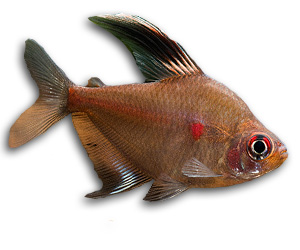Bleeding Heart Tetra

Quick Stats
| Size | About 2.5" (6cm) |
|---|---|
| Tank | 20 litres and above for a small school |
| Swimming Area | Bottom, middle |
| Ph | 5.5 to 7.3 |
| Temperature | 73ºF to 82ºF (23-28°C) |
| Food | Flakes and Bloodworm |
Common Name:
Bleeding Heart Tetra.
Distribution:
South America, the Amazon and other waters in Columbia.
Colouration:
The upper side is orange to brown with a reddish tinge. The underside is a silvery red. The body and throat are a pinkish orange. On each side of the fish is a bright red mark ringed with a iridescent scales, this is where its common name came from. The front of the dorsal fin is red with a large black dot. The anal fin has a triangular white area. The upper half of the iris is red and the eyes have a black cross band.
Lifespan:
3 to 5 years.
Maintenance:
10% weekly water changes. Said to be sensitive to poor water conditions the bleeding heart can be a great member of a community set up.
Feeding:
Flakes and Bloodworm.
Substrate:
A sandy bottom is best.
Tank Decor:
The tank should be well planted either using live or plastic plants and be dimmed with some floating material. They are more sensitive to light than most so an arraignment of dark colors is better . A shy fish you will need to provide hiding places but also leave open spaces for swimming.
Filtration:
Filter suitable to the size of tank in which they are housed.
Biotype:
Heavily vegetated small streams and rivers of its range.
Breeding:
Although it has been reported, this fish is a challenge as all conditions have to be perfect. Isolate and condition the male in a tank containing many fine leafed plants such as Myriophyllum, Cabomba and some Java moss, also include some floating material as well. After a few days introduce the female to the tank. After the mating ritual the eggs are scattered among the plants . Remove parents after eggs are laid. Fry hatch after 2-3 days and are free-swimming after a few more. They must be fed the finest of foods like baby brine and crushed flake.